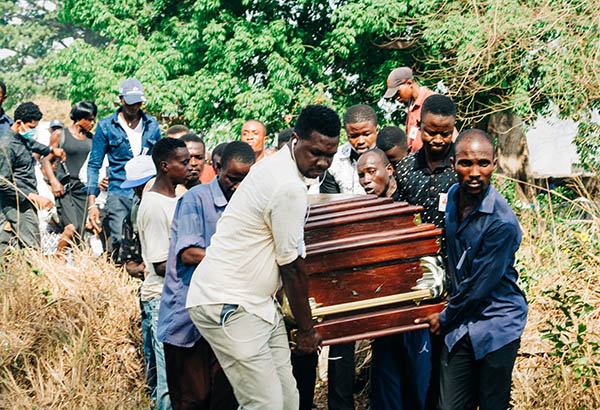
Water, Weeping & Emotional Regulation through the Grieving Process

– Composed by Rebecca Bourhill, Edited by Glenn Nangaku Leisching
Introduction
In basic terms, trauma is an event or experience that creates extreme stress that overwhelms an individual’s ability to cope. It can be broken up into three parts: the event, what the person experienced, and the effects. These elements combined can describe trauma as an event, incident, occasion or a set of circumstances that is experienced by an individual as physically or emotionally harmful that has lasting effects on the individual’s functioning and mental, physical, social, emotional, or spiritual well-being. We will go into more depth on the effects of trauma in part two. It is helpful to keep in mind that what one may experience as trauma is often different from what another may see as trauma. There is often a story behind why an event was traumatic to an individual and it is important to keep this in mind when in the presence of someone that may be facing a challenging set of circumstances. Toward the end of the blog, we look at the water element and how shedding tears are vital for emotional regulation and to maintain homeostasis in the body.
The effects of trauma and the consequences of suppressing emotional pain
The effects of trauma can impact an individual in many areas affecting daily functioning. The effects are often what can be seen as a result of a set of circumstances or an event that has been experienced. Built-up and suppressed toxic stress from the event can cause further issues. The acute symptoms of trauma are not too unfamiliar to most of us. These can range from: anger, sadness, feeling out of control, feeling overwhelmed, anxiety, numbness, nausea, and extreme fatigue. If the acute trauma responses are not worked through effectively, delayed or suppressed responses can cause problems further on. These include but are not limited to depression, anxiety (including phobias), irritability, fear of the trauma reoccurring, brain fog, indecisiveness, the need to grieve, appetite changes, hyperarousal, consistent fatigue, auto-immune conditions and other long-term health effects.
An individual that has had any form of trauma occurs can find it challenging to regulate emotions. This is more evident in cases when the event has happened in childhood but can be the case at any age. If the trauma happens to an older individual that is fully functioning beforehand, it is said that the emotional regulation is not too long-lasting.
In short – trauma creates biological changes and stress responses in the body – specifically the limbic system and increases cortisol production (the harmful stress hormone). These changes are what is associated with mental health conditions and long-term health outcomes, and it is, therefore, important to find ways in which to release these overwhelming feelings. Medication for depression and anxiety together with therapy is the most widely known to help manage the symptoms. There are more natural ways, however, such as exercise, grieving loss, meditation, and mindfulness. There is one method though that has more negative connotations than it deserves. And that is the cathartic means of tears, grieving, and crying. From here on out we will look deeper into how shedding tears ties into the water element and can be beneficial to mind, body, and soul.


Benefits of weeping
Although tears trigger social bonding and connection, it is more than a visible shout for help. They detoxify the body, ridding itself of excess enzymes, lipids, metabolites, and electrolytes. Tears from emotional release are said to contain more proteins and consist of stress hormones (cortisol) and other toxins that continuous tears which are 98% water (responsible for lubricating the eyes) and reflex tears due to debris, dust, and smoke do not contain.
More research needs to be done but the possible reason for tears being so cathartic is their chemical composition. Along with the substances mentioned above, an extended period of weeping activates the parasympathetic nervous system (rest and digest mode) and releases oxytocin and endorphins which are feel-good hormones. These ease both physical and emotional pain which can often be followed by a ‘numb’ state which could be put down to the calming effects of oxytocin.
Conclusion
It is clear that tears have a profound impact on our emotional and physical states. Rather than seeing crying as a sign of weakness, we should recognize their potential for healing and embrace their power to bring relief and release. By acknowledging the importance of the water element and the role of tears in our lives, we can better understand and support those who have experienced trauma and provide them with the compassion and empathy they need to heal.
References:
Ashish. (2021, December 10). The Water Element: Symbolism, Meaning, Functions and More. Fitsri, www.fitsri.com/articles/5-elements-water . [accessed 11 July 2023].
Center For Substance Abuse. (2014). Understanding the Impact of Trauma. National Library of Medicine. https://www.ncbi.nlm.nih.gov/books/NBK207191/#:~:text=Delayed%20responses%20to%20trauma%20can,with%20the%20trauma%2C%20even%20remotely[Accessed: 11 July 2023]
Marcin, A. (2017, April 14). 9 Ways Crying May Benefit Your Health. Healthline; Healthline Media. https://www.healthline.com/health/benefits-of-crying [accessed: 11 July 2023]
Oaklander, M. (2016, March 16). The Science of Crying. Time. https://time.com/4254089/science-crying/ . [accessed: 11 July 2023]





